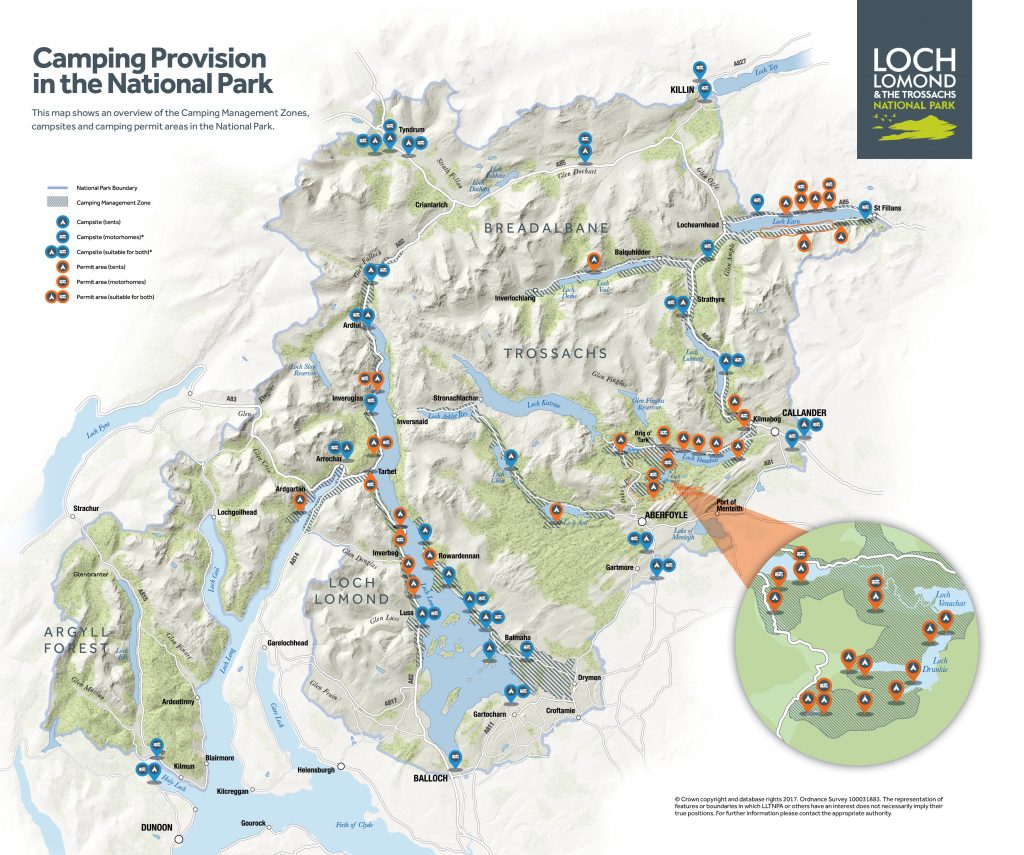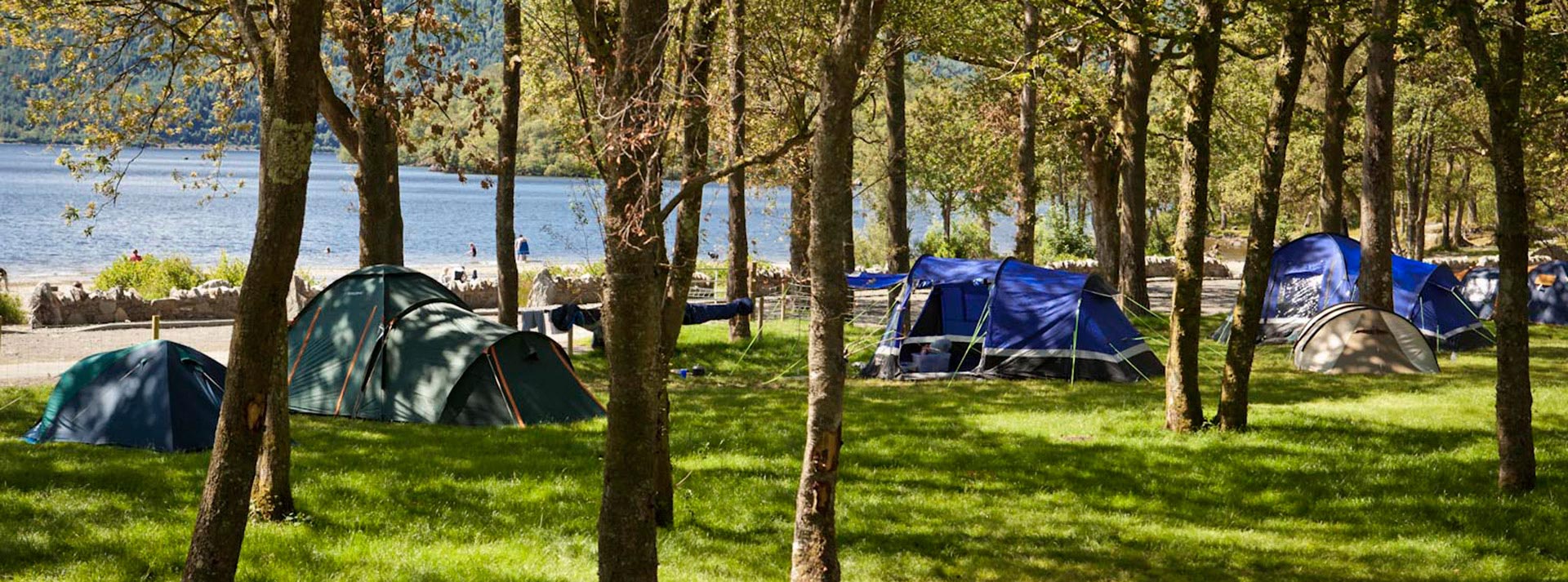
National Park welcomes campers as new byelaws come into effect
As new camping byelaws come into effect, the Loch Lomond & The Trossachs National Park Authority are reminding visitors that all kinds of camping are still welcome in the Park.
The seasonal byelaws are new regulations which manage pressures and damage caused by camping and firelighting in less than four per cent of the National Park and came into effect on 1st March 2017. Alongside this the Park Authority has provided over 300 camping and motorhome places in the byelaw zones bookable through a new easy to use website.
Gordon Watson, Chief Executive of Loch Lomond & The Trossachs National Park, said: “Camping is one of the best ways to get out and enjoy the stunning surroundings we have in the National Park and there is every kind of camping experience on offer here.
“The new byelaws do not change that. Whether you’re an experienced camper, coming on your own or with your friends and family, there is still a wide choice of places to camp in the National Park. To support this we have opened a new campsite in the Trossachs at Loch Chon and are promoting some excellent locations to ‘wild camp’ with a permit.
“Our focus just now is on making everyone coming to camp in the Park fully aware of how the byelaws work and of all the camping options available to them.”
For those who love the solitude of ‘wild camping’, the vast majority of the Park’s 720 square miles will experience no change to camping at all.
Between March and September, people keen to camp or stay overnight in a motorhome or campervan at one of the many popular and picturesque lochshore locations throughout the Park, can do so by buying a camping permit or booking a pitch at a campsite. Alongside a comprehensive guide to all of the commercial campsites in the National Park, permits are available online from the National Park authority at www.lochlomond-trossachs.org/camping
In addition to the many privately-run campsites throughout the National Park, there are low-cost, informal campsites with bookable pitches, parking, fresh water and toilets at Loch Chon, and Loch Lubnaig in the Trossachs. There is also Forest Enterprise Scotland’s campsite at Sallochy on East Loch Lomond.
The byelaws create four Camping Management Zones which are in place from March to September. To camp in these Zones during this period, visitors need to have a valid permit to camp in a permit area, or stay over in a campsite.
Camping permits cost just £3 per tent, motorhome or campervan per night and can be booked online up to eight weeks in advance. The new campsite at Loch Chon costs £7 per adult per night, with under-16s going free. Costs at other privately-run campsites vary.
Laybys are not affected by the new camping management byelaws. People with campervans and motorhomes can still use laybys in the Camping Management Zone to stop and rest (including sleeping overnight if necessary), but encampment on a road (including laybys) is an offence under road traffic legislation and will be managed by Police Scotland accordingly, in cooperation with land owners.
The National Park also provides permit areas specifically for motorhomes and campervans at Three Lochs Forest Drive, Inveruglas and Firkin Point. These lovely locations are designed for informal, short stays of a maximum of three nights. Permits for staying overnight in these spaces can be booked online.

The byelaws also cover firelighting. If you have a fire when you are camping it should be small, under control, and you should bring your own firewood. Causing damage such as chopping trees for firewood is also a breach of the byelaws.
The Camping Management Zones are focused around the National Park’s busiest lochshore locations which attract very high numbers of campers year on year. This volume, combined with the antisocial behaviour of a minority of campers over a number of years, has a significantly damaging effect on the environment and a negative impact on other visitors and local communities.
Gordon Watson said: “The aim of the byelaws is to protect these precious locations and make sure everyone can enjoy them now and in the future. Given the dramatic transformation seen on East Loch Lomond since byelaws were introduced there in 2011, we are confident we will see improvements with more responsible behaviour and less damage to the environment.
“Our focus as always is to encourage and support people to enjoy the National Park while at the same time protecting its special environment.

“Our Rangers continue welcoming people and educating them on all the aspects of the Park. This includes providing information to make sure all visitors can camp responsibly. Our experience on East Loch Lomond is that most people want to do the right thing to help look after such a special place. This is not about looking to catch people out who might be camping in the wrong place; as taking formal action would always be a last resort, but helping them understand where and how they can camp responsibly.
“The first season of the byelaws being in place gives us an opportunity to fine tune their operation. We will be closely monitoring how the byelaws and camping provision are working. In particular, we are keen to gather feedback from campers and other visitors, as well as local communities, and partner organisations through our Stakeholder Forum.”
Anyone camping in Scotland must follow the Scottish Outdoor Access Code which includes adhering to any local byelaws. For more information, please visit the Scottish Outdoor Access Code website.
In the most extreme cases of those who refuse to comply with the byelaws, a report could be sent to the Procurator Fiscal who could impose a potential fine of up to £500. Any criminal record would be imposed at the court’s discretion.
Further information about camping in the National Park, including the byelaws, detailed maps of the Camping Management Zones and the booking system for camping permits can be found on our website.

